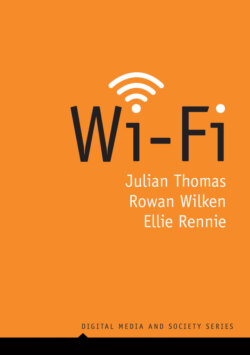Wi-Fi

Реклама. ООО «ЛитРес», ИНН: 7719571260.
Оглавление
Ellie Rennie. Wi-Fi
Table of Contents
List of Illustrations
Guide
Pages
Series Title. Digital Media and Society Series
Wi-Fi
Copyright Page
Figures
Acknowledgements
1 Why Wi-Fi Matters
Why Wi-Fi?
Wi-Fi through past and present
Wi-Fi is a brand
Wi-Fi combines new and old technologies
Wi-Fi’s histories are diverse and contested
Overview of chapters
2 Infrastructure
What is an infrastructure?
Wi-Fi is self-provided
Spectrum as infrastructure
Wi-Fi hardware and its precursors
Wi-Fi standards
Wi-Fi infrastructure and development
Conclusion
3 Home
The domestication of Wi-Fi
Imagination
Appropriation
Objectification
Incorporation
Conversion
The connected home
Conclusion – Wi-Fi and the domestication and transformation of the home
4 Community
Community
Community infrastructure cooperatives
The rise of community networks
Warchalking
Community Wi-Fi as open infrastructure
Community innovation
Community informatics
Mesh networks
The limits of community-based Wi-Fi networks
Community governance and Wi-Fi
Conclusion
5 City
Communication technologies and the city in history
Device portability and the diffusion of city Wi-Fi
Cafés and the social life of Wi-Fi
The politics and economics of city Wi-Fi
The promise of public Wi-Fi for access and equity
Wi-Fi and smart cities
Conclusion
6 Problems, Prospects, Possibilities
Wi-Fi in the short run
Wi-Fi in the long run
Wi-Fi’s social futures?
Bibliography
Index
POLITY END USER LICENSE AGREEMENT
Отрывок из книги
Julian Thomas,
Rowan Wilken, and
.....
When Steve Jobs unveiled the iBook laptop, he didn’t talk about Wi-Fi – the wireless networking features were branded with an Apple trademark, ‘AirPort’, conveying the idea that these industry standard capabilities would be ‘first and best’ on Apple’s machines. As other firms began to build those same capabilities into many other computers and base stations, the AirPort name inevitably became one of many used to market wireless networking gear. What became known as Wi-Fi was generally designated as ‘802.11’, the number given to the relevant family of wireless standards developed for local networks within the Institute of Electrical and Electronics Engineers, known as the IEEE.
For those manufacturers and developers keen to promote the new standards, several issues were quickly apparent. Jobs emphasized the fact that AirPort used the new industry standard, and therefore would work with a whole array of devices soon to appear. But the 802.11 standards were complex and wide-ranging, with the result that not all compliant devices using the same standard were assured to work together, and the IEEE’s role in specifying the agreed standard did not extend to testing devices for compliance. Further, 802.11 was, as we have noted, a family of standards, with each iteration given a specific alphabetic suffix. The standard used in Apple’s 1999 iBook and other early consumer systems was 802.11b, to be followed in time by 802.11g, 802.11n, 802.11ac, and many others. These different versions of Wi-Fi all involved significant improvements, but the nomenclature was difficult to follow or comprehend for those without specialist knowledge.
.....